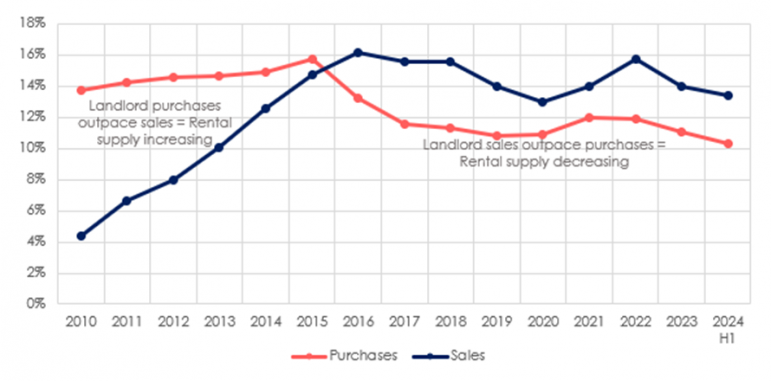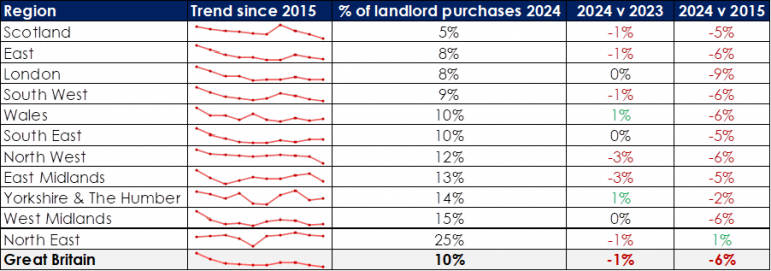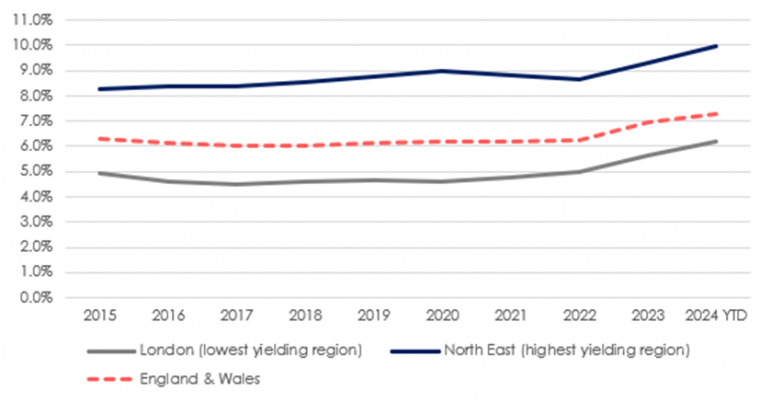 Buy-to-let is no longer the investment of choice for many investors, new figures suggest.
Buy-to-let is no longer the investment of choice for many investors, new figures suggest.
Landlords purchased one in ten (10%) homes sold across Great Britain during the first half of this year. This is the lowest share since our records began in 2010 and is considerably less than the 16% recorded in 2015 – before tax and regulatory changes were introduced, which reduced the appeal of investment in buy-to-let.
More recently, high mortgage rates combined with political uncertainty and the threat of new rental regulations have weighed on the appetite for new investors to enter the market. The share of investor purchases has been gradually falling over the course of the year, reaching a low of 9.7% in June.
Assuming current trends continue into the second half of the year, in number terms, there are likely to be 113,630 new buy-to-let purchases across Great Britain in 2024, 75,900 or 40% fewer than in 2015.
Landlord purchases have fallen in every region except the North East since 2015. The North East is the highest-yielding region in the country and is where investors remain most active. Here, the share of homes bought by a landlord has risen slightly from 24% in 2015 to 25% in 2024.
London, the lowest-yielding region in the country, has seen the biggest decline in new landlord purchases. The share of homes bought by landlords in the capital has more than halved, from 17% in 2015 to an all-time low of 8% so far this year. Lower rental returns, on average, in the capital have given landlords less headroom to cover higher costs.
Landlord purchases by region:
Source: Hamptons
However, Scotland has the lowest level of investor purchases. Buy-to-let investors bought just 5% of homes sold in Scotland so far this year, down from 10% in 2015 and 7% in 2019. Tighter rental regulations were introduced in Scotland during Covid alongside a new 6% stamp duty surcharge on second home purchases at the end of 2022.
High mortgage rates mean that new buy-to-let investors are increasingly focusing on the highest-yielding areas to make the sums stack up. Six of the ten local authorities with the highest share of buy-to-let purchases are in one of the three Northern regions (table 2). Sunderland tops the list, where 45% of homes were bought by an investor during the first half of the year. Swindon, Enfield and Torbay are the only Southern local authorities to make the top 10 list.
Table 2 – Top 10 buy-to-let purchase hotspots
| Local Authority | Region | Share of homes bought by a landlord H1 2024 |
| Sunderland | North East | 45% |
| Middlesbrough | North East | 43% |
| Derby | East Midlands | 32% |
| Swindon | South West | 30% |
| Enfield | London | 29% |
| Darlington | North East | 29% |
| Liverpool | North West | 26% |
| Blackpool | North West | 26% |
| Torbay | South West | 24% |
| Preston | North West | 24% |
Source: Hamptons
The lack of new investment comes despite yields rising to record highs across the country. Strong rental growth combined with stagnant property prices meant that the average investor purchasing a new buy-to-let in England and Wales this year achieved a gross yield (before costs and taxes) of 7.3%, a whole percentage point more than in 2015, and up from 7.0% in 2023.
In cash terms, this means a typical investor would earn an extra £1,906 a year in rent on a £200,000 purchase than if they had bought in 2015 at a yield of 6.3%. However, higher mortgage rates and the inability to fully offset these payments (unless owning in a limited company) have reduced post-tax buy-to-let profits for most higher-rate taxpaying landlords.
Some 16% of new investors achieved a gross yield in excess of 10% this year, up from 14% in 2023 and more than double the share who achieved double-digit returns back in 2016 (7%).
Chart 2 – Average gross yield achieved on a new buy-to-let purchase
Source: Land Registry & Hamptons
Despite cost pressures and wider uncertainty about future rental reform, there is no sign that more landlords are selling up. In fact, the share of homes sold by a landlord has been falling for the last three years. Private landlords accounted for 13% of all sellers in Great Britain so far this year, down from 14% in 2023 and 16% in 2022.
Even so, landlords are still selling more properties than they’re buying, which is reducing the number of homes available to rent (chart 1). This trend has held in each year since 2016, when the 3% stamp duty surcharge on second home purchases was introduced and it was announced that some landlords could no longer fully offset their mortgage payments against their tax bills. These changes increased the cost of purchasing an investment property and reduced the profitability of existing mortgaged buy-to-lets for many landlords.
Based on current trends, we estimate that a further 146,060 homes will be sold by private landlords across Great Britain this year. This will more than offset the 113,630 new buy-to-let purchases in 2024 and will likely mean that private landlords will have sold 328,750 more rental homes than they’ve bought since 2016.
While institutional investment into larger rental developments (primarily Build-to-Rent) has filled some of this void, there are still fewer homes available to rent than before. There were 42% fewer rental homes on the market across Great Britain last month than in June 2016.
The low supply of rental homes continues to put upward pressure on rents. The average tenant paid £1,347 pcm to rent a new home in Great Britain last month, 5.8% or £74 pcm more than if they moved last year (table 3). This means rents are rising nearly three times faster than inflation (CPI=2.0% in June).
Tenants moving into a new home in Scotland faced the biggest increases. Here, rents on newly let properties rose 11.1% year-on-year, marking the 39th consecutive month when rental growth exceeded 5%.
However, London is slowing the pace of rental growth across Great Britain. Average rents on newly let properties in London increased 2.7% year-on-year, the weakest annual growth rate recorded since October 2021. This figure was pulled down by Inner London where rents fell for the third consecutive month following 14.8% annual growth in June last year. Meanwhile, rents in the North of England are still rising at double-digit pace.
Rental growth on newly let properties in June 2024
| Average Rent pcm | YoY % | YoY £ | |
| Greater London | £2,331 | 2.7% | £60 |
| Inner London | £3,065 | -0.2% | -£7 |
| Outer London | £2,192 | 3.5% | £73 |
| East of England | £1,281 | 7.0% | £84 |
| South East | £1,425 | 6.1% | £83 |
| South West | £1,175 | 5.1% | £57 |
| Midlands | £975 | 8.5% | £76 |
| North | £927 | 10.0% | £84 |
| Wales | £818 | 6.7% | £52 |
| Scotland | £962 | 11.1% | £96 |
| Great Britain | £1,347 | 5.8% | £74 |
| Great Britain (Ex London) | £1,094 | 7.6% | £77 |
Source: Hamptons
Aneisha Beveridge, head of research at Hamptons, said: “Rather than a mass landlord sell-off, the lack of homes available to rent has been caused by fewer investors entering the market. Tax and regulatory changes introduced since 2016 have been the main culprit, but these disincentives to invest have been compounded more recently by higher interest rates and political uncertainty around the threat of more rental reform.
“If investor purchases and sales continued at 2015 levels, there would likely be 450,000 more private rental homes in Great Britain by the end of this year. This is roughly equivalent to the total number of homes in Birmingham. Most investor purchases this year have been driven by cash-rich, larger portfolio landlords who continue to expand their portfolios.
“The lack of supply is one of the main factors underpinning strong rental growth and this is unlikely to reverse any time soon. The challenge for the new government, which is keen to boost homeownership, is to increase security and the quality of homes for tenants living in the rental sector without disincentivising or pushing out more landlords. While some of the homes that previously would have been bought by an investor have found their way into the hands of a first-time buyer, high mortgage rates and rising rents are likely to lock out many would-be homeowners over the next few years, keeping them in the rental sector for longer.”





No surprise there then.
You must be logged in to like or dislike this comments.
Click to login
Don't have an account? Click here to register
BTR is likely to be the new investment asset class for those wanting to be ‘in property’ but without the hassle. But BTR isn’t targeted at the lower end of the PRS. It’s for the more affluent renter with higher income, in core cities.
You must be logged in to like or dislike this comments.
Click to login
Don't have an account? Click here to register
Does air B&B count under buy-to-let figures? Probably the reason some areas are still getting investment.
Landlord forums would indicate to me that government policy is the biggest single factor against more investment – and driving many out.
What do the agents think?
You must be logged in to like or dislike this comments.
Click to login
Don't have an account? Click here to register
How can this be? Surely recent surveys indicated that around 40% of landlords were considering adding to their portfolios in the next year! That’s the trouble with surveys unless they are put together properly the information you get from them is flawed, worse still, you can design a survey to give you the result you want which is what a lot of surveys on these pages do as they are put together by people with vested interests. The fact (and we assume it is a fact) that BTL mortgages are on the decline would certainly seem to give the lie to all the landlords increasing their portfolio surveys.
You must be logged in to like or dislike this comments.
Click to login
Don't have an account? Click here to register
If Labour go ahead with their net zero plans and reintroduce EPC’s C. We will see an epidemic of evictions.
You must be logged in to like or dislike this comments.
Click to login
Don't have an account? Click here to register